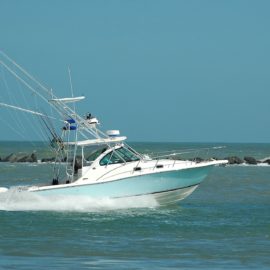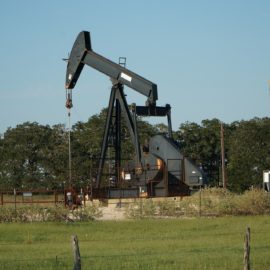
Texas has better winds but Louisiana has a more friendly political climate so we may get the wind turbines first.
The Texas coast may have better winds for offshore wind development, but it’s Louisiana’s political winds that are drawing the interest of the industry’s two biggest players. Orsted and RWE, which rank No. 1 and No. 2 in the booming offshore wind market, both highlighted Louisiana’s political support for offshore wind in letters to federal energy regulators tasked with readying the Gulf of Mexico for what could be a flurry of offshore wind development. RWE, a German company that has renewable energy operations in 15 countries, urged regulators to focus on Louisiana despite studies showing Texas has a clear advantage with stronger, more consistent wind speeds. “To date, Louisiana is the only state along the Gulf of Mexico that has signaled its interest in pursuing an offshore wind policy to meet its climate objectives,” Kate McKeever, an RWE manager of U.S. government affairs, told the U.S. Bureau of Ocean Energy Management, also known as BOEM.
nola.com
It is the Governors Climate Task Force that shows our political will.
RWE cited the Louisiana Climate Initiatives Task Force’s latest draft climate plan, which highlights the need to rapidly develop offshore wind in the Gulf to reduce the state’s greenhouse gas emissions and meet Gov. John Bel Edwards’ goal of “net zero” carbon emissions by 2050. The draft plan, released late last month, proposes enacting an offshore wind energy goal of 5,000 megawatts by 2035. “With the development of renewable energy policy in Louisiana, there is a pathway with a timeframe of when commercial viability may be achieved,” McKeever said. “As such, RWE Renewables recommends that BOEM prioritize advancing a leasing area off Louisiana, specifically western Louisiana due to stronger wind speeds.” The Gulf’s sweet spot for offshore wind development may be the coastal waters near Lake Charles, according to RWE.
This is welcome news to the state and the governors office.
Louisiana Economic Development Secretary Don Pierson welcomed RWE’s interest. “It feels very much like validation to me,” he said Friday. “I like the way we’re positioning policy and corporate interest in the sector to grow opportunities for offshore wind and other renewables.” RWE’s comments “underscore how taking action on climate change can support economic growth,” said Harry Vorhoff, senior staffer for the climate task force and deputy director of the Governor’s Office of Coastal Activities. He pointed to a National Renewable Energy Laboratory study that estimated a hypothetical wind project near Lake Charles would create about 4,470 construction jobs and generate $445 million in goods and services. Once constructed, the wind farm would support 150 jobs and an annual infusion of $14 million into the economy from operations, maintenance and materials.
In addition to the political will we also have the needed industrial traits in those transitioning from the oil and gas industries.
Many of the skill sets and resources required for offshore wind are already plentiful in Louisiana. Several steel fabrication, engineering and vessel operations companies that serviced Louisiana’s offshore oil and gas industry are shifting their focus to the several offshore wind projects taking shape along the East Coast. The NREL study found that the Texas coast had the strongest potential for offshore wind development, thanks largely to stronger winds. Despite having weaker, less dependable winds, Louisiana was still seen as a strong contender because of its offshore oil and gas workforce, which has seen many jobs evaporate with falling fuel prices and a shift in extraction to inland sources of shale. Whether the climate task force’s wind energy goal will gain much traction is unclear. Vorhoff said achieving it will require collaboration between the Edwards administration, the state Public Service Commission, federal government, utilities, and the private sector.
Some of the task force’s ideas do carry weight in the country.
Similar goals, known as renewables portfolio standards, have had big impacts elsewhere in the country. About half of the renewable energy sector’s growth since 2000 is thanks to state-level renewable standards, according to the U.S. Department of Energy. Thirty states, including California, New York and North Carolina, have passed renewables standards, as well as dozens of cities. Last year, New Orleans passed a renewables standard that requires all of the city’s power to come from wind, solar and other emission-free sources by 2050. Renewables standards spur the development of renewable energy projects because they guarantee a market for the power they produce. That’s especially important for offshore wind farms, which can cost billions of dollars and take years to plan and permit. Denmark-based Orsted also singled Louisiana out in a recent letter to BOEM. The company applauded Edwards for pushing BOEM to establish the Gulf of Mexico Intergovernmental Renewable Energy Task Force, a group that began meeting in June to help plan offshore wind development on the Outer Continental Shelf.
These letters are part of the second phase of this process.
The letters were submitted to BOEM as it completes a second phase of gathering input on offshore development in the Gulf. Federal lease planning could conclude next year, followed by a five-year site assessment process. Turbines might start spinning over the Gulf as early as 2028. Other energy companies that have submitted letters expressing interest in developing wind energy in the Gulf include Royal Dutch Shell, Texas oil company Talos, Enterprize Energy of Singapore, Ocean Wind of Portugal, Total Energies of France, and Avangrid, a Connecticut power company owned by Spain-based Iberdrola. Avangrid joined RWE in sending a second letter of interest to BOEM last month. Off the Massachusetts coast, Avangrid is developing Vineyard Wind, the first commercial-scale offshore wind project in the U.S. The company has mapped areas it might want to build turbines off the Texas coast near Galveston and Corpus Christi and a 20-mile-wide stretch south of Lake Charles. While Orsted and RWE were less specific about potential wind farm locations, the companies bring immense size and stature to the pool of firms exploring wind development in the Gulf. RWE currently has 2,400 megawatts of offshore wind capacity in operation, while Orsted recently topped 7,000 megawatts, supplying enough power for more than 6.6 million homes.
Texas or Louisiana doesn’t matter as workers from here will e involved but having off our coast will be both a political win as well as an industrial one as we gain more renewable energy.



